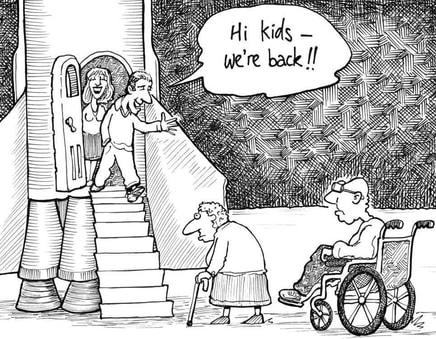|
Prior to 1905 the concept of relativity was the term where we simply discussed ones experiences from your own frame of reference. The car you see stationary beside you is actually moving relative to the ground, only because you are also moving with that car. (This is discussed here) But then in 1905 Albert Einstein developed his special Theory of Relativity. Because of the constancy of the speed of light he determined that the relativity understanding that was known at the time had flaws. Resolving this he determined that, rather than being absolute, time, momentum and length became relative. The following lessons explores the development of Einstein's special theory of relativity |
Michelson and Morley
In 1861 James Clerk Maxwell theorised that light was a form of electromagnetic radiation, with a set speed, but what speed was this relative to?
Earlier we discussed that all velocities were relative - dependent on the observer but there was no factor in Maxwell's equations that allowed for this.
It was hypothesised that there must exist a medium for light to travel through that was the frame of reference for the speed of light, called luminiferous aether.
Albert Michelson and Edward Morley set out to detect this aether.
Although Einstein himself did not consider the results of Michelson and Morley's experiment as necessary for his development of Theory of Relativity, the experiment is nonetheless important that indirectly supported both Maxwell's theories and the postulates that underpin Einstein's.
This video discusses the concepts qualitatively. If you want to see the mathematical analysis underpinning Michelson and Morley's work, check out the video.
Earlier we discussed that all velocities were relative - dependent on the observer but there was no factor in Maxwell's equations that allowed for this.
It was hypothesised that there must exist a medium for light to travel through that was the frame of reference for the speed of light, called luminiferous aether.
Albert Michelson and Edward Morley set out to detect this aether.
Although Einstein himself did not consider the results of Michelson and Morley's experiment as necessary for his development of Theory of Relativity, the experiment is nonetheless important that indirectly supported both Maxwell's theories and the postulates that underpin Einstein's.
This video discusses the concepts qualitatively. If you want to see the mathematical analysis underpinning Michelson and Morley's work, check out the video.
|
|
If you are wondering about the mathematics involved, watch this video
|
Conclusion
Its important to note that this experiment did not conclusive disprove the idea of an aether. It was simply a null result - an experiment whose result simply provided no evidence of this aether.
In fact the experiment was repeated numerous times, as late as 1930, by Joos, to see if aether could be detected. Again, null results were recorded.
Its important to note that this experiment did not conclusive disprove the idea of an aether. It was simply a null result - an experiment whose result simply provided no evidence of this aether.
In fact the experiment was repeated numerous times, as late as 1930, by Joos, to see if aether could be detected. Again, null results were recorded.

